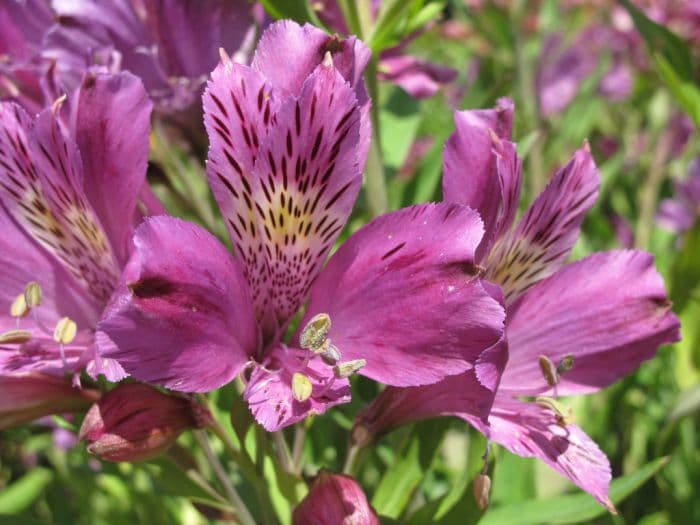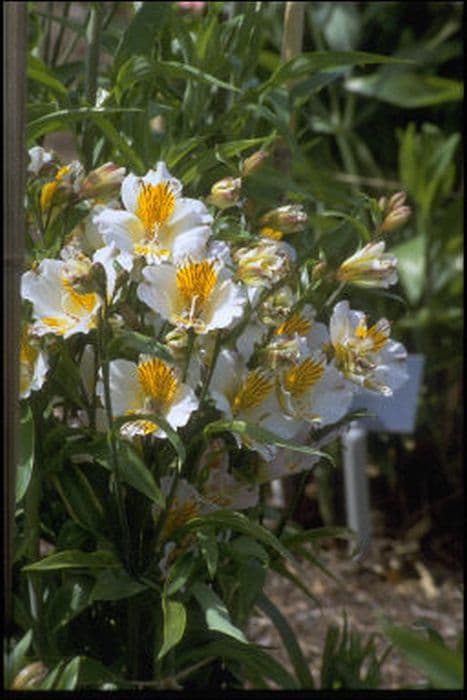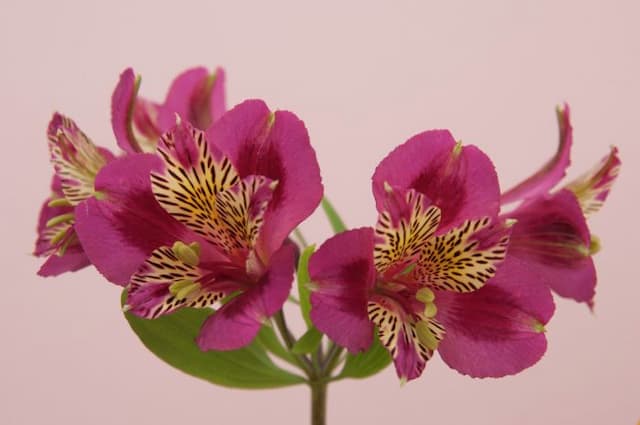Peruvian Lily Alstroemeria 'Perfect Blue'

ABOUT
Alstroemeria 'Perfect Blue', commonly known as the Peruvian Lily or Lily of the Incas, is notable for its striking and exotic-looking flowers. The blossoms feature a blend of soft lavender and periwinkle blue petals, each intricately detailed with dark streaks or markings that lead to a central white throat. The coloration may display varying shades of blue and sometimes a hint of pink might emerge. Each flower possesses six slightly curved petals, producing a star-like shape with a tropical aura. The leaves of the Peruvian Lily 'Perfect Blue' are narrow, lance-shaped, and typically display a rich green color. These leaves often twist as they emerge from the stems, adding to the plant's overall lush and dynamic appearance. The foliage provides a pleasing contrast to the delicate texture and cool tones of the flowers. The flowering stems of this cultivar rise above the foliage and are topped with umbels or clusters of the beautiful blooms. Typically, multiple flowers are found on each stem, creating a plentiful display whenever the plant is in bloom. This makes the Peruvian Lily 'Perfect Blue' a popular choice for both gardens and cut flower arrangements, where its long-lasting blooms and unique coloration can be thoroughly enjoyed.
About this plant
 Names
NamesFamily
Alstroemeriaceae.
Synonyms
Peruvian Lily, Lily of the Incas, Parrot Lily.
Common names
Alstroemeria 'Perfect Blue'.
 Toxicity
ToxicityTo humans
The Alstroemeria, commonly known as the Peruvian Lily or Lily of the Incas, is generally not considered highly toxic to humans. However, it can cause irritation if the sap comes in contact with skin, leading to dermatitis in some individuals. If ingested, the plant may cause mild gastrointestinal symptoms such as nausea, vomiting, or diarrhea. It is always recommended to handle plants with care and to avoid ingesting any plant matter unless it is known to be safe for consumption.
To pets
The Peruvian Lily is considered to be of mild toxicity to pets, particularly cats and dogs. If a pet ingests a part of this plant, they may experience mild gastrointestinal upset, which can include symptoms such as vomiting or diarrhea. It is not typically known to cause severe poisoning in pets, but if you suspect your pet has ingested this plant, it is best to consult with a veterinarian to ensure they receive proper care and attention.
 Characteristics
CharacteristicsLife cycle
Perennials
Foliage type
Deciduous
Color of leaves
Green
Flower color
Mixed
Height
2-3 feet (60-90 cm)
Spread
1-2 feet (30-60 cm)
Plant type
Bulb
Hardiness zones
7
Native area
South America
Benefits
 General Benefits
General Benefits- Long-lasting blooms: Alstroemeria 'Perfect Blue' produces abundant flowers that can last for several weeks, providing a long period of visual enjoyment.
- Aesthetic appeal: The striking blue flowers add a unique and vibrant touch to gardens and floral arrangements.
- Attracts pollinators: The blossoms attract bees and butterflies, supporting local ecosystems and aiding in plant pollination.
- Hardiness: It is known for being a hardy plant that can withstand a range of growing conditions, making it suitable for many gardeners.
- Low maintenance: Requires minimal care beyond the basics of watering and occasional feeding, making it ideal for busy or novice gardeners.
- Drought resistance: Once established, the plant has a degree of drought tolerance, reducing the need for frequent watering.
- Versatility: Suitable for borders, pots, and as cut flowers, adding versatility in landscaping and interior decoration.
 Medical Properties
Medical PropertiesThis plant is not used for medical purposes.
 Air-purifying Qualities
Air-purifying QualitiesThis plant is not specifically known for air purifying qualities.
 Other Uses
Other Uses- Photography Backdrop: The Alstroemeria 'Perfect Blue', with its vivid colors, serves as an excellent natural backdrop for macro and portrait photography.
- Eco-friendly Confetti: The petals of the Peruvian Lily can be dried and used as biodegradable confetti for events and celebrations.
- Natural Dye: The pigments of the Peruvian Lily flowers can be used to create natural dyes for fabrics or art projects.
- Culinary Garnish: Although not widely recognized for culinary use, the petals can be used to add a splash of color to salads and desserts as long as they are pesticide-free.
- Handmade Paper: Incorporating the petals into the papermaking process can produce beautifully textured and colored handmade papers.
- Artistic Inspiration: Due to their striking appearance, Peruvian Lilies can inspire patterns and designs in arts like textile design or painting.
- Education and Science: Peruvian Lilies can be used in botanical studies to educate about plant biology, hybridization, and horticultural practices.
- Floral Art Supplies: The sturdy stems and distinct flowers are excellent materials for creating floral arrangements or installations.
- Holiday Decorations: The flowers and foliage can be incorporated into wreaths, centerpieces, or other holiday decorations due to their durability and color.
- Scented Accessories: Although not overly fragrant, the subtle scent of Peruvian Lily can be captured in potpourri or scented sachets.
Interesting Facts
 Feng Shui
Feng ShuiThe Peruvian lily is not used in Feng Shui practice.
 Zodiac Sign Compitability
Zodiac Sign CompitabilityThe Peruvian lily is not used in astrology practice.
 Plant Symbolism
Plant Symbolism- Devotion and Friendship: Alstroemeria, commonly known as Peruvian Lily or Lily of the Incas, often symbolizes a strong bond of friendship and the mutual support between friends.
- Wealth, Prosperity and Fortune: The multiple colors of the Peruvian Lily, including the 'Perfect Blue', can represent a richness in personality or a wish for wealth and prosperity.
- Endurance: The hardiness and long-lasting nature of the Peruvian Lily blooms are seen as a symbol of endurance and the ability to withstand challenges.
- Achievement: The elaborate and intricate petals of the Peruvian Lily can signify achievement and reaching one's goals, as the flower itself stands out in any arrangement.
 Water
WaterPeruvian lilies, including the 'Perfect Blue' variety, should be watered thoroughly once the top inch of soil feels dry to the touch. Generally, this means watering approximately every 7 to 10 days, but this will vary depending on environmental conditions. When watering, aim to moisten the soil evenly without leaving standing water, using about 1 gallon for outdoor plants or slightly less for those in containers. Adjust the frequency during particularly hot or dry periods by increasing it and reduce the amount of water during colder, rainy months to prevent overwatering.
 Light
LightPeruvian lilies thrive in bright indirect sunlight or partial shade. The 'Perfect Blue' variety will perform best when placed in a location that receives morning sun followed by afternoon shade. Too much direct sunlight can scorch the leaves, while too little will hinder flowering, so finding the right balance is key for this plant's health.
 Temperature
TemperaturePeruvian lilies, such as 'Perfect Blue,' prefer temperatures between 65 and 80 degrees Fahrenheit. They can withstand minimum temperatures down to about 50 degrees Fahrenheit but are not frost-tolerant. The ideal temperature range promotes healthy growth and flowering, while extreme cold or heat can damage the plant.
 Pruning
PruningPruning Peruvian lilies, including the 'Perfect Blue' variety, encourages vigorous growth and more blooms. Prune by removing dead or faded flowers and cutting back stems that have finished blooming. This can be done throughout the flowering season to maintain the plant's shape and vitality. The best time for significant pruning is early spring or after the plant has finished its bloom cycle in the fall.
 Cleaning
CleaningAs needed
 Soil
SoilThe best soil mix for Peruvian Lily 'Perfect Blue' should be well-draining, rich, and light, with a combination of peat, pine bark, and coarse sand or perlite. Ensure the soil pH is slightly acidic to neutral, ranging from 6.0 to 7.0.
 Repotting
RepottingPeruvian Lilies should be repotted every two to three years as they are vigorous growers. Repotting is best done in spring just before the growing season begins.
 Humidity & Misting
Humidity & MistingPeruvian Lily 'Perfect Blue' prefers moderate humidity levels, aiming for about 40-50%. Avoid environments that are too dry or overly humid.
 Suitable locations
Suitable locationsIndoor
Place in bright indirect light and ensure good air circulation.
Outdoor
Plant in partial shade to full sun, sheltered from wind.
Hardiness zone
7-10 USDA
 Life cycle
Life cycleThe Alstroemeria 'Perfect Blue', commonly known as the Peruvian Lily or Lily of the Incas, starts its life as a tuberous rhizome planted in well-draining soil during spring. This perennial plant then germinates and grows into a leafy stem, with leaves growing in a resupinate fashion, twisted at the base so that the underside is facing upwards. As it matures, it develops multiple buds that bloom into the characteristic funnel-shaped blue to lavender flowers with contrasting streaks and speckles, typically during the summer months. After pollination, which is often aided by insects, the Peruvian Lily sets seed capsules if the conditions permit, although many varieties are sterile and do not produce viable seeds. Once the flowering season ends, the plant goes dormant in the fall or winter, with the foliage dying back, and the rhizome remains dormant underground until the next growing season. This cycle of growth, flowering, and dormancy repeats annually, with the rhizomes able to survive for several years, making Alstroemeria 'Perfect Blue' a reliable and colorful addition to perennial gardens.
 Propogation
PropogationPropogation time
Spring-Early Summer
The Alstroemeria 'Perfect Blue', commonly known as Peruvian Lily or Lily of the Incas, can be propagated through division, which is the most popular method for this plant. This process is ideally done in late winter or early spring before new growth begins. To propagate by division, carefully dig up the plant and gently separate the rhizomes, ensuring that each section has at least one growth bud. Replant the divisions immediately at the same soil depth they were growing previously, spacing them about 12 to 18 inches (30 to 45 cm) apart. It is important to water the new plants well after planting to help establish them.





![Peruvian lily [H.R.H. Princess Alice]](/_next/image?url=https%3A%2F%2Fplants-admin.emdemapps.com%2Fimages%2Fplants%2F%2Fimages%2F604b55e81c8b0.png&w=640&q=75)

![Peruvian lily [Inca Coral]](/_next/image?url=https%3A%2F%2Fplants-admin.emdemapps.com%2Fimages%2Fplants%2F%2Fimages%2F604b5b79b85ce.png&w=640&q=75)
![Peruvian lily [Inca Exotica]](/_next/image?url=https%3A%2F%2Fplants-admin.emdemapps.com%2Fimages%2Fplants%2F%2Fimages%2F604b5ec0e34a9.png&w=640&q=75)
![Peruvian lily [Inca Milk]](/_next/image?url=https%3A%2F%2Fplants-admin.emdemapps.com%2Fimages%2Fplants%2F%2Fimages%2F604b5f14b0b6a.png&w=640&q=75)